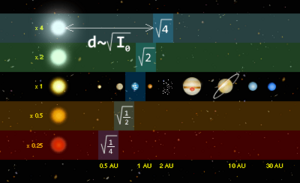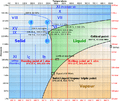Habitable zone facts for kids
A habitable zone (also called HZ) in astronomy is a special area in space. In this zone, conditions are just right for life to form, similar to how it did on Earth. Planets found in these areas are the most likely places to have extraterrestrial life, which means life from other planets.
You might also hear the habitable zone called the "life zone," "comfort zone," "green belt," or "Goldilocks zone." Scientists think that about one out of every five stars has an Earth-sized planet in its habitable zone. However, we don't know yet how many of these planets actually have the right conditions for life to exist.
Contents
Goldilocks Planet: Just Right for Life
The Goldilocks principle or 'Goldilocks effect' means that something has to be within certain limits. It's like saying, "not too hot, not too cold, but just right."
This idea comes from the children's story "The Story of the Three Bears". In the story, a girl named Goldilocks finds a house belonging to three bears. Each bear has their own favorite things, like food or beds. Goldilocks tries each one and finds that one is always too much of one extreme (like too hot or too big). Another is too much of the opposite extreme (like too cold or too small). But one is always "just right."
In astrobiology, the Goldilocks zone refers to the habitable zone around a star. For a planet to support life, it must not be too far from its star, and it must not be too close. It also needs to be in a good spot within its galaxy. If a planet is too far or too close, it would be very hard for life to develop. A planet like this, that is "just right," is often called a "Goldilocks planet."
How We Find Habitable Zones
The Zone Around a Star
In a Solar System, astronomers believe a planet needs to be in the habitable zone to have life. This area around a star is called the circumstellar habitable zone. In this zone, a planet could have liquid water. Liquid water is thought to be very important for all known forms of life.
Bigger stars are usually hotter. So, their circumstellar habitable zone would be farther away from the star than it is for our Sun. Smaller stars are cooler. This means their habitable zone would be closer to the star than the Sun's. The size and brightness of a star help scientists figure out where its circumstellar habitable zone is located.
Scientists look at several things to decide if a planet might be habitable:
- Earth Similarity Index (ESI) — This number shows how much a planet is like Earth, from 0 (not like Earth) to 1 (very much like Earth). It looks at the planet's radius (size), density (how packed it is), and surface temperature.
- Habitable Zone Distance (HZD) — This measures how far a planet is from the center of its star's habitable zone. A value of -1 means it's at the inner edge, and +1 means it's at the outer edge.
- Planetary Class (pClass) — This sorts planets by how hot they are (hot, warm, or cold). "Warm" means it's in the habitable zone. It also sorts them by size (like Earth-sized, or bigger like Neptune or Jupiter).
- Habitable Class (hClass) — This classifies habitable planets by their temperature. "Mesoplanets" are medium-temperature (0–50 °C), which would be best for complex life. Planets that are very cold or very hot might only support special kinds of life called extremophiles, which can live in extreme conditions. Planets that are not habitable are simply called NH.
The Zone Within a Galaxy
This idea is not used as often, but it suggests that a solar system also needs to be in a good spot inside a galaxy for life to form.
Some parts of galaxies are better for life than others. Our own Solar System, located in the Orion Arm on the edge of the Milky Way galaxy, is a good place for life. Here's why:
- It's not in a globular cluster. These are areas with many stars packed very closely together. Too many stars mean too much radiation and strong gravity, which would be bad for life.
- It's not near a strong source of gamma rays, which are very dangerous.
- It's not too close to the galactic center. The center has many stars packed together, increasing the chance of harmful radiation from things like magnetars (super magnetic stars) and supernovae (exploding stars). A supermassive black hole is also thought to be at the galaxy's center, which could be dangerous.
- The Sun's circular orbit around the galactic center helps keep it away from the galaxy's spiral arms. These arms can also have intense radiation and gravity that could disrupt life.
What is a Habitable Planet Candidate?
The habitable zone is the area around a star where a planet has enough air pressure to keep liquid water on its surface.
A habitable planet candidate is a terrestrial planet (a rocky planet like Earth) that is in this zone. It also has conditions that are similar to Earth's. This means it could potentially be a good place for life.
So far, only about a dozen planets have been officially confirmed to be in a habitable zone. However, the Kepler spacecraft has found another 54 planets that might be candidates. Scientists believe there could be "at least 500 million" such planets in our Milky Way galaxy alone!
List of Habitable Planet Candidates
The table below lists some planets that are considered candidates for being habitable. You can sort the table by clicking the arrows next to the column titles.
- Key
- Distance from Earth in light-years (ly)
- Mass in Earth mass multiples (M⊕)
- Radius in Earth radii (R⊕)
| Planet name | Distance from Earth [ly] | Mass [M⊕] | Radius [R⊕] | Discovery date | Notes | Ref. |
|---|---|---|---|---|---|---|
| Gliese 581 g | 20.5 | 3.10 | 1.65 | 2010-09-29 | First habitable planet candidate found | |
| Gliese 667 Cc | 22 | 4.5 | -- | 2009-10-19 | ||
| HD 85512 b | 36 | 3.60 | 2.50 | 2011-08-17 | ||
| GJ 1214 b | 40 | 6.55 | 2.68 | 2009-12-16 | ||
| 55 Cancri f | 41 | 45.77 | 2.00 | 2005-04-11 | ||
| Kepler-22b | 600 | 34.96 | 2.40 | 2011-05-12 | ||
| Kepler-47c | 4900 | Neptune-sized | Neptune-sized | 2012-08-29 | ||
| PH2 b | Jupiter-sized | 2013-01-03 |
Related pages
Images for kids
-
A diagram showing the habitable zone boundaries around stars, and how they change based on the star type. This includes planets from our Solar System (Venus, Earth, and Mars) and important exoplanets like TRAPPIST-1d, Kepler-186f, and Proxima Centauri b.
-
This shows different ideas for how big the Sun's habitable zone is. The dark-green band shows the "conservative" zone, which includes Earth. A lighter-green band shows an "extended" zone, which goes out to the orbit of the dwarf planet Ceres.
-
A comparison of the habitable zone position of Earth-sized planet Kepler-186f and our Solar System (from April 17, 2014).
See also
 In Spanish: Zona de habitabilidad para niños
In Spanish: Zona de habitabilidad para niños












